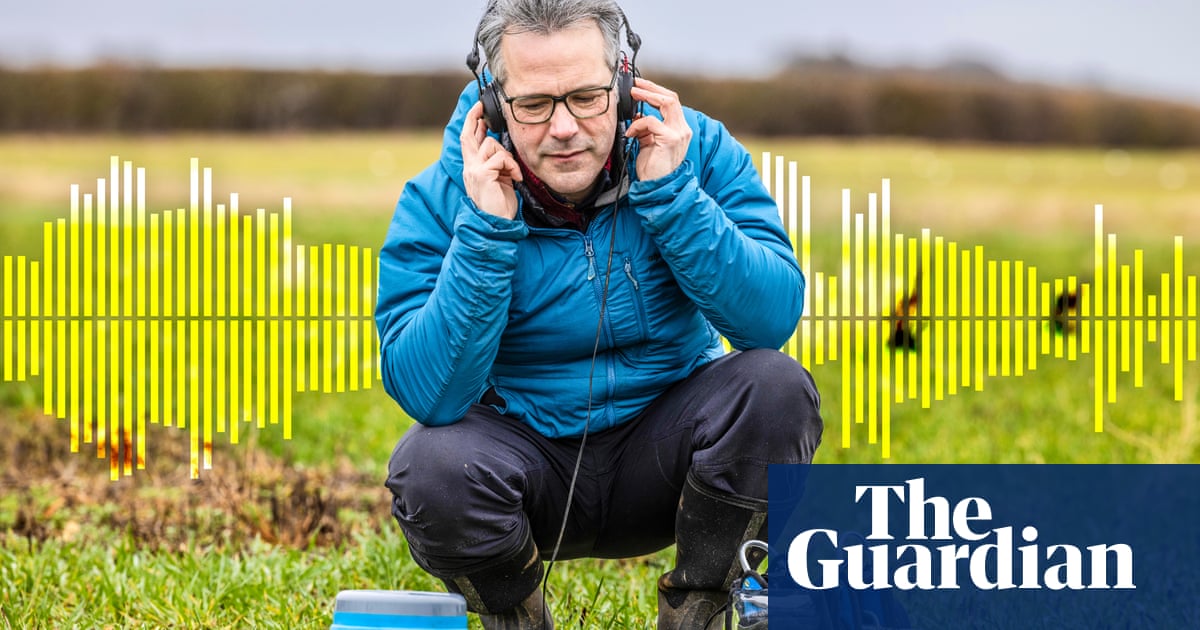The sound of an earthworm is a distinctive rasping and scrunching. Ants sound like the soothing patter of rain. A passing, tunnelling vole makes a noise like a squeaky dog’s toy repeatedly being chewed.
On a spring day at Rothamsted Research, an agricultural research institution in Hertfordshire, singing skylarks and the M1 motorway are competing for the airways. But the attention here is on the soundscapes underfoot: a rich ecosystem with its own alien sounds. More than half of the planet’s species live in the soil, and we are just starting to tune into what they are up to. Beetle larvae, millipedes, centipedes and woodlice have other sound signatures, and scientists are trying to decipher which sounds come from which creatures.
In a field divided up into test strips, Carlos Abrahams pushes a sensor the length of a knitting needle into the soil. With a pair of headphones on, he listens to the “poor man’s rainforest”: a dark landscape of miniature caves, tunnels and decomposing matter stewing away under our feet.
“A few ticks and clicks going on,” says Abrahams, an ecoacoustics specialist from Baker Consultants, as he listens in.
Abrahams and scientists from the University of Warwick are building up libraries of subterranean sounds. The soil makes different noises depending on the season and whether it’s night or day. Even in the afternoon when the soil has warmed up, sounds get richer, research suggests.
“The soil is such a mystery,” says Dr Jacqueline Stroud, from the University of Warwick’s Crop Centre. “This is like opening the door and seeing what is going on below ground. It’s a different way of exploring the world.”
Until recently, soil had been a relative blank spot for monitoring species abundance. Farmers and gardeners hoping to find out how healthy their soils were had to dig up spadefuls and carry out laborious tests.
Last year, a study found soil was the single most species-rich habitat on Earth, with more than half of all species living in it. But only a fraction have been identified, and most are too small to see. Soundscapes are becoming an increasingly popular way of monitoring wildlife abundance, above ground, beneath the earth and underwater.
Noisy soil is generally healthier because it contains a greater range of bugs and worms busying around. Soil organisms alter and improve the structure of soil by passing nutrients between one another and creating an environment that is well ventilated and diverse. These webs provide food, fibre and clean water for people – topsoil is where 95% of the planet’s food is grown.
Soils that have little biodiversity are more fragile: they have lost the structure and connections that keep particles together. This means they are more likely to be washed away by floods or blown away by strong winds. An estimated 24bn tonnes of fertile soil is lost every year through intensive farming, according to a UN-backed study, the Global Land Outlook.
Farmers have repeatedly asked for more efficient ways of measuring the abundance of earthworms, which are a good indicator of the heath of soils, according to researchers.
Baker Consultants and the University of Warwick have funding for a two-year research project developing a recording unit prototype. The aim is to record soil sounds at “big data” scales.
On the land Abrahams is testing, scientists are trialling more ecological ways of farming, including crop rotations with legumes and higher proportions of oats. In total there are 70 scientists working on this bit of land, marked out in 66 plots of 24m by 24m, finding out new things about soil structure, viruses, microbes and fungi – making it among the most studied soil in the world. “It’s a unique outdoor laboratory,” says Kim Hammond-Kosack from Rothamsted Research, who set up the experiments.
Abrahams and Stroud’s teams started their sampling at Rothamsted in October last year. Each month they take two recordings on each of the plots, measuring how activity above the ground affects what is happening in the soil.
Dr Simon Butler from the University of East Anglia has been listening to the soil before and after the application of zebra dung in Eswatini (previously known as Swaziland). The soil fizzed with activity post-application. “I’ve never really considered the sound of soils, so it was fascinating to hear how the acoustic properties change in response to the presence of fresh dung,” he says.
The sounds being produced are within the lower range of human hearing, so it’s possible there are sounds in the soil we haven’t heard yet. Early research from Switzerland shows soils were producing the most complex sounds in spring and summer, which declined in autumn and winter. Abrahams’ previous research has shown that soils in restored forests in the UK seem to have a greater diversity of sounds than soil from deforested plots. He says: “As a general rule, the more diverse it is above ground, the more that is going on in the soil.”
In January, researchers published what they believe is the first paper listening to tropical forest soils, which are among the most biodiverse habitats in the world. Like others, they documented multiple mysterious sounds. The next task is to create a library of soil sounds so they can work out what they’re actually listening to.
Find more age of extinction coverage here, and follow biodiversity reporters Phoebe Weston and Patrick Greenfield on X for all the latest news and features



